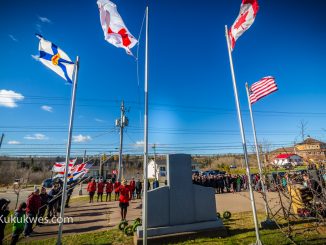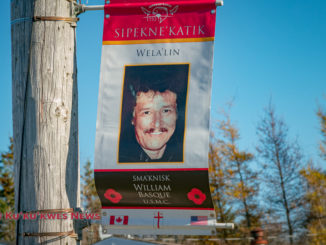
Newfoundland and Labrador cabinet minister Lisa Dempster said it was emotional for her as she followed high school students who took part in the Trail of Caribou Pilgrimage earlier this month.
“I was behind doing a little video on my phone as our students walked the hill, and they were the same age as those young soldiers would have been; I am usually not at a loss for words, but it is hard to articulate all the emotions that we were feeling,” the minister responsible for Indigenous Affairs and Reconciliation recalled.
Dempster, along with 41 youths and students, was part of the group that embarked on the Trail of Caribou pilgrimage, with ceremonies that took place in France and Belgium from July 4 to July 10.
Among the 41 students were ten youths representing five Indigenous governments: Nunatsiavut Government, Innu Nation, NunatuKavut Community Council, Miawpukek First Nation, and Qalipu First Nation.

Carla Benoit, a youth representing the Miawpukek First Nation, says she did not know what to expect going into the pilgrimage but came out of it grateful for the experience.
Benoit, who is currently in Grade 11, says she did not know much about WWI going into the pilgrimage as the history behind it was not taught in school for them.
“Before this, I really thought the war was useless, and in a certain sense it is, but it is good to understand and appreciate the sacrifice, bravery and selflessness of the soldiers who served in the war,” Benoit said.
Benoit said she has many relatives who fought in war, so it is hard to pinpoint specific ones but adds that WWI has had a generational impact on her family.
“My great-grandparents on my mom’s side of the family had relations that fought in the war, so the war has really impacted my family line, so finding out even small patches of information on how it affected them was eye-opening,” Benoit said.
First time Indigenous Youth included in pilgrimage
Dempster says this was the first time the provincial government has partnered with Indigenous youths for the pilgrimage.

“Having Indigenous youths be a part of the pilgrimage was great because there were Indigenous soldiers that served in the war, and not a lot of people are aware of this,” Dempster said.
Dempster says that Indigenous and non-Indigenous youths interacting and sharing their perspectives together is crucial as it helps them understand history accurately and, in turn, contributes to reconciliation efforts.
Benoit echoes a similar sentiment.
“It is important to have Indigenous students attend and share their knowledge to provide a perspective different from the westernized perspective,” Benoit said.
“There are students there who come with knowledge from the textbook and just one perspective, so having Indigenous representatives put forth a different insight on it as well,” she added.
Benoit says learning about the contributions of Indigenous veterans helps build community as well.
“It increased the patriotism in our community as well, so we were able to actively engage in the Remembrance Day ceremony and have that connection with WWI,” she said.

Dempster says a memorable moment from the pilgrimage was the bus ride back where each and every one of the students shared what they took from the experience and everyone had something unique to say.
“We spent more than a week walking through rows and rows of headstones with names engraved and many with no name or a soldier known only on to God…I think we all came back with a fresh sort of feeling that the names are engraved on stones over there and we came back with those young men forever in a new way engraved in our hearts,” Dempster said.



